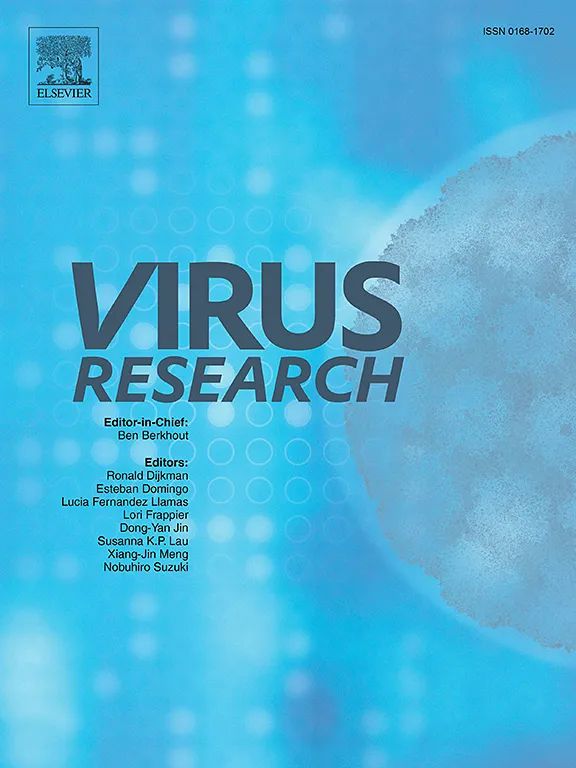Phylogenetic analysis linked fatal neurologic disease in leopards (Panthera pardus) to Asia-5 lineage of canine distemper virus in Nepal
IF 2.5
4区 医学
Q3 VIROLOGY
引用次数: 0
Abstract
Canine distemper virus (CDV) is responsible for a highly contagious and often fatal neurological disease that affects various carnivores, including domestic dogs. In Nepal, recent reports of CDV exposure and illness in leopards (Panthera pardus) have raised concerns about the transmission of the virus among domestic dogs and wild carnivores. To investigate the genetic lineage and spread of CDV, our study utilized archived post-mortem samples from four leopards that exhibited clinical signs suggestive of canine distemper infection. These leopards were rescued in the Palpa, Dolakha, Kathmandu, and Parbat districts. Our phylogenetic analysis revealed that the CDV strains circulating among the leopards belong to the Asia-5 lineage, which is also prevalent among dogs and wild carnivores in Nepal and neighboring India. The genetic relatedness between the leopard CDV sequences and those from both dogs and other carnivores within the Asia-5 lineage suggests that leopards in Nepal may have acquired the virus from multiple sources, potentially facilitated by their generalist dietary habits preying on dogs and even mesocarnivores. Furthermore, we inspected specific amino acid substitution in the hemagglutinin gene of leopard CDV, which also suggests possible transmission from both domestic dogs and non-canid hosts, although further research is needed to draw definitive conclusions. Given the vulnerable state of the leopard population in Nepal, already threatened by poaching and retaliatory killing, the emergence of CDV as a potential novel threat is deeply concerning. Comprehensive surveillance studies are essential to understand the dynamics of CDV spillover and to develop informed interventions. Urgent measures, including vaccination programs and effective control of the dog population, are needed to mitigate the impact of this disease and safeguard the future of Nepal's leopards and other wild carnivores.
系统发育分析将尼泊尔豹(Panthera pardus)的致命神经系统疾病与犬瘟热病毒的亚洲-5系联系起来。
犬瘟热病毒(CDV)是一种传染性极强的神经系统疾病,通常会对包括家犬在内的各种食肉动物造成致命影响。在尼泊尔,最近有关豹子(Panthera pardus)接触 CDV 并患病的报道引起了人们对家犬和野生食肉动物之间病毒传播的担忧。为了研究 CDV 的遗传系谱和传播途径,我们的研究利用了四只豹子的死后存档样本,这些豹子出现了提示感染犬瘟热的临床症状。这些豹子是在帕尔帕、多拉卡、加德满都和帕尔巴特地区救治的。我们的系统发育分析表明,在豹子中流行的 CDV 株系属于亚洲-5 系,该系在尼泊尔和邻近印度的狗和野生食肉动物中也很流行。豹CDV序列与狗及其他食肉动物的CDV序列之间的遗传相关性表明,尼泊尔的豹可能从多个来源获得了病毒,而它们捕食狗甚至中食肉动物的普遍饮食习惯可能为其获得病毒提供了便利。此外,我们还检查了豹 CDV 血凝素基因中的特定氨基酸替换,这也表明病毒可能从家犬和非犬科动物宿主中传播,但要得出确切结论还需要进一步研究。尼泊尔的花豹种群已经受到偷猎和报复性杀戮的威胁,处于脆弱状态,因此 CDV 作为一种新的潜在威胁出现令人深感忧虑。全面的监测研究对于了解 CDV 蔓延的动态和制定明智的干预措施至关重要。需要采取包括疫苗接种计划和有效控制狗群在内的紧急措施来减轻这种疾病的影响,保护尼泊尔豹和其他野生食肉动物的未来。
本文章由计算机程序翻译,如有差异,请以英文原文为准。
求助全文
约1分钟内获得全文
求助全文
来源期刊

Virus research
医学-病毒学
CiteScore
9.50
自引率
2.00%
发文量
239
审稿时长
43 days
期刊介绍:
Virus Research provides a means of fast publication for original papers on fundamental research in virology. Contributions on new developments concerning virus structure, replication, pathogenesis and evolution are encouraged. These include reports describing virus morphology, the function and antigenic analysis of virus structural components, virus genome structure and expression, analysis on virus replication processes, virus evolution in connection with antiviral interventions, effects of viruses on their host cells, particularly on the immune system, and the pathogenesis of virus infections, including oncogene activation and transduction.
 求助内容:
求助内容: 应助结果提醒方式:
应助结果提醒方式:


